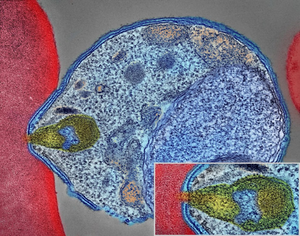Difference between revisions of "Malaria"
| Line 10: | Line 10: | ||
: [[Malaria]] is transmitted by the mosquito which is referred to as a [[Vector (Disease)|vector]] for the [[pathogen]]. | : [[Malaria]] is transmitted by the mosquito which is referred to as a [[Vector (Disease)|vector]] for the [[pathogen]]. | ||
: [[Malaria]] is not easily treated and most people will have [[malaria]] for their entire lives. | : [[Malaria]] is not easily treated and most people will have [[malaria]] for their entire lives. | ||
| + | : People with the [[Genetic Disorder|genetic disorder]] '[[Sickle Cell Anemia]]' have sickle shaped [[Red Blood Cell|red blood cells]] which helps prevent '''malaria''' [[infection]]s. | ||
The transmission of [[malaria]] can be prevented or reduced by: | The transmission of [[malaria]] can be prevented or reduced by: | ||
*Killing mosquitos with [[insecticide]]. | *Killing mosquitos with [[insecticide]]. | ||
Revision as of 11:18, 6 June 2019
Key Stage 4
Meaning
Malaria is a disease caused by pathogenic protists called Plasmodia.
About Malaria
- The malaria protist lives in the blood of humans and reproduces in the liver.
- Malaria can lay dormant, not causing any symptoms, for months at a time.
- Malaria causes fevers, liver damage and damage to the red blood cells.
- Malaria is transmitted by the mosquito which is referred to as a vector for the pathogen.
- Malaria is not easily treated and most people will have malaria for their entire lives.
- People with the genetic disorder 'Sickle Cell Anemia' have sickle shaped red blood cells which helps prevent malaria infections.
The transmission of malaria can be prevented or reduced by:
- Killing mosquitos with insecticide.
- Destroying the habitat of the mosquito. (Areas of stagnant water.)
- Taking antimalarial drugs.
- Using mosquito nets that can be placed over beds.
